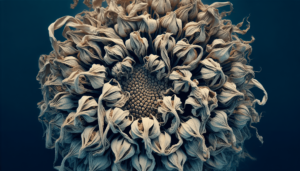Climate change has become an increasingly pressing issue, affecting not only the environment but also the global economy. The ramifications of this phenomenon are far-reaching, influencing various sectors and industries. In this article, we explore the economic impacts of climate change and shed light on the consequences we face as a result. From fluctuating natural resource prices to the costs of adapting infrastructure, we examine the intricate web of challenges that lie ahead. Prepare to delve into the complex web of climate change and its effects on our wallets.
Agricultural Impacts
Climate change poses significant challenges to the agricultural sector, resulting in various economic impacts. One of the primary concerns is crop yield losses. Rising temperatures, changing precipitation patterns, and increased frequency of extreme weather events can negatively affect crop productivity. This leads to reduced harvests, lower yields, and ultimately, financial losses for farmers. In addition, climate change also brings about changes in crop patterns. Some regions may become unsuitable for certain crops, forcing farmers to adapt their practices or switch to alternative crops. These adjustments can incur additional costs and may require new investments in equipment, seeds, and technology.
Another consequence of climate change is the increased demand for water and irrigation. As temperatures rise and rainfall patterns become more erratic, water resources become scarce, and agriculture becomes more water-dependent. This leads to higher irrigation costs, as farmers need to access and distribute water efficiently to sustain crop growth. Additionally, climate change can disrupt food supply chains. Extreme weather events, such as hurricanes or heatwaves, can damage infrastructure and transportation systems, causing delays, spoilage, and even the loss of perishable crops. These disruptions can result in higher food prices and reduced access to food, affecting both consumers and producers.
What Are The Economic Impacts Of Climate Change?
Natural Resource Impacts
Climate change has detrimental effects on natural resources, which have significant economic implications. One of the most apparent consequences is the decreased availability of freshwater. As temperatures rise and precipitation patterns change, water scarcity becomes a pressing issue in many regions. This scarcity affects various sectors, including agriculture, energy, and industry, leading to increased costs for water supply and infrastructure. It can also create competition for water resources, potentially resulting in conflicts and disputes.
Climate change also contributes to an increase in extreme weather events. More frequent and severe hurricanes, floods, and droughts can damage ecosystems and infrastructure, leading to substantial economic losses. These events disrupt various industries, such as tourism, agriculture, and fisheries, and require significant investments in disaster response and recovery. Additionally, climate change threatens biodiversity and ecosystem services. Changes in temperature, rainfall, and habitats can negatively impact plant and animal species, disrupting ecosystems and reducing their capacity to provide essential services, such as pollination, pest control, and water purification. The loss of these services can have profound economic consequences.
Furthermore, climate change affects the forestry sector and the timber industry. Changes in temperature, precipitation, and natural disturbances, such as wildfires or insect outbreaks, can impact forest health and productivity. This poses challenges for timber harvesting and reduces the availability of wood products. Ultimately, the forestry sector faces declining revenues, job losses, and lower economic contributions.
Health and Social Impacts
Climate change poses significant health and social impacts, which have economic repercussions. One of the most concerning consequences is the increased disease burden. Rising temperatures create favorable conditions for the spread of vector-borne diseases, such as malaria, dengue fever, and Lyme disease. Heatwaves also pose risks to human health, leading to heat-related illnesses and death. These health challenges require additional healthcare resources and result in higher healthcare costs, which burden individuals, healthcare systems, and governments.
Moreover, climate change can lead to the displacement of populations. Sea-level rise, floods, and extreme weather events can force people to leave their homes and seek shelter elsewhere. This displacement creates social challenges, including the need for emergency housing, healthcare, and basic supplies, and puts a strain on local resources and infrastructure. Additionally, climate change can contribute to social unrest and conflicts, particularly in regions where it exacerbates existing challenges, such as poverty, inequality, and resource scarcity. These conflicts disrupt social and economic stability, hinder development, and require significant investments in peacekeeping and resolution efforts.
Infrastructure Impacts
Climate change can have significant impacts on infrastructure, resulting in economic implications. One of the primary concerns is the damage to buildings and structures. Extreme weather events, such as hurricanes, storms, or floods, can cause substantial damage to infrastructure, including homes, businesses, roads, and utilities. The costs of repairing and rebuilding these structures can be significant and burden both individuals and governments. Additionally, climate change increases the costs for infrastructure repairs. Higher temperatures and changing precipitation patterns intensify wear and tear on roads, bridges, and other infrastructure, requiring more frequent maintenance and replacement.
Transportation systems are also vulnerable to climate change impacts. Extreme weather events can disrupt transportation networks, leading to delays, closures, and increased costs for repair and recovery. These disruptions affect business operations, supply chains, and daily commuting, resulting in economic losses for individuals, companies, and governments. Moreover, climate change leads to increased insurance costs for infrastructure. As the frequency and severity of extreme weather events rise, insurance premiums for homes, buildings, and other infrastructure increase to compensate for the higher risks. These higher costs impact individuals, businesses, and governments, who have to allocate more resources to maintain insurance coverage.
Tourism and Recreation Impacts
Climate change significantly affects the tourism and recreation industry, resulting in economic impacts. Negative effects on tourist destinations are a major concern. Rising temperatures, sea-level rise, and changing landscapes can alter the appeal and availability of popular destinations. Coastal areas, for instance, are vulnerable to erosion and flooding, which can damage resorts, beaches, and other attractions. Additionally, climate change contributes to the loss of biodiversity and natural attractions. Changes in ecosystems and habitats can reduce the diversity of flora and fauna, diminishing the unique experiences that draw tourists.
The decline in visitor numbers is another consequence of climate change. Extreme weather events and changing climatic conditions can discourage travelers from visiting certain locations, either due to safety concerns or unfavorable conditions. As a result, tourism-dependent regions experience reduced visitor numbers, impacting local businesses, jobs, and revenues. Furthermore, climate change can directly lead to the loss of tourism revenue. Events like hurricanes or natural disasters can damage infrastructure and disrupt tourism operations, resulting in canceled bookings, revenue losses, and the need for costly recovery efforts.
Energy Impacts
Climate change affects the energy sector, leading to various economic impacts. Increased energy consumption for cooling is a significant concern. As temperatures rise, the demand for electricity to power air conditioning units and cooling systems also increases. This leads to higher energy usage, which, in turn, requires additional power generation and distribution infrastructure. These investments incur costs for energy providers and consumers, impacting electricity prices and the economy as a whole.
Conversely, climate change also leads to decreased energy production in some regions. Changing precipitation patterns can affect hydropower generation, reducing the availability of renewable energy sources. Extreme weather events, such as storms or hurricanes, can damage energy infrastructure, disrupt operations, and halt power production. This reliance on fossil fuels for energy production poses economic challenges, as fossil fuel prices can fluctuate and create dependency on limited resources.
Moreover, higher costs for energy infrastructure are a consequence of climate change. As extreme weather events become more frequent and severe, energy infrastructure, including power grids, transmission lines, and power plants, face risks of damage and disruption. To withstand these challenges, investments in strengthening and adapting energy infrastructure need to be made, resulting in increased costs. These expenses can place financial burdens on energy providers, governments, and ultimately, energy consumers.
Economic Disruptions
Climate change poses various economic disruptions, affecting multiple sectors and industries. One of the most prominent impacts is a decline in the agricultural and forestry sectors. As climate conditions change, farmers and foresters face challenges in adapting their practices and maintaining productivity. These difficulties lead to lower yields, reduced revenues, and job losses in these sectors. Furthermore, increased costs for disaster response and recovery contribute to economic disruptions. As extreme weather events become more frequent and severe, the need for emergency services, infrastructure repairs, and support services rises. These costs burden governments, individuals, and businesses, diverting funds away from other investments and priorities.
Additionally, climate change results in the loss of livelihoods. Many industries, particularly those reliant on natural resources, face significant challenges as climate conditions change. Fishing industries, for example, experience declining fish stocks and changing habitats, affecting the livelihoods of fishermen and related businesses. Similarly, communities dependent on sectors like agriculture, tourism, or forestry may suffer from reduced incomes and job opportunities. These disruptions can lead to social and economic inequalities, posing challenges for individuals and policymakers alike.
Moreover, climate change can hinder GDP growth. The economic impacts outlined above, such as job losses, declining sectors, increased costs, and disruptions to various industries, contribute to lower GDP growth rates. Climate change-induced challenges do not just affect specific sectors but have ripple effects throughout the economy. Reduced economic stability, decreased investments, and the need for additional resources to address climate-related challenges impede overall economic growth.
Insurance and Financial Impacts
Climate change has substantial implications for the insurance and financial sectors, resulting in economic challenges. One such impact is increased insurance premiums. As the frequency and severity of extreme weather events rise, insurance companies face higher risks, leading to increased premiums for policies covering homes, businesses, and infrastructure. These higher costs burden individuals, businesses, and governments, who rely on insurance coverage to mitigate climate-related risks.
Furthermore, climate change poses greater financial risks for insurers. The increasing frequency and severity of extreme weather events increase the potential for large-scale insurance claims and payouts. This can strain the financial stability and sustainability of insurance companies and may require them to reevaluate their coverage limitations and pricing strategies. Additionally, property value depreciation is a consequence of climate change. Properties in high-risk areas, prone to flooding or other climate-related hazards, may experience decreasing values. This depreciation not only affects property owners but also impacts the mortgage and real estate industries.
Moreover, climate change poses losses in the banking and financial sector. As extreme weather events damage infrastructure, businesses, and properties, these losses can translate into loan defaults, bankruptcies, and reduced financial stability for borrowers. As a result, financial institutions face risks and challenges in managing their portfolios, potentially impacting lending practices and access to credit for individuals and businesses.
Migration and Labor Impacts
Climate change has significant impacts on human migration patterns and labor, with notable economic consequences. Increased migration and refugee crises are consequences of climate change. Rising sea levels, droughts, floods, and other climate-related challenges can render certain areas uninhabitable, forcing people to move to safer regions. These population movements incur costs for both host areas and the areas of origin, as resources and infrastructure need to accommodate larger populations, and governments need to address humanitarian needs.
In addition, climate change leads to the loss of jobs in affected sectors. Industries heavily reliant on natural resources or climate-sensitive activities, such as agriculture, fisheries, or tourism, face challenges as climate conditions change. Job losses occur as these sectors decline or adapt their practices, impacting individuals and communities who depend on these industries. Conversely, cooler regions or areas less affected by climate change may experience increased labor productivity as conditions become more favorable. This can result in labor shifts and changes in regional economies, with potential impacts on wages, skills, and economic disparities.
Furthermore, climate change affects labor-intensive industries. Extreme weather events, rising temperatures, or changing climatic conditions can disrupt supply chains, affect productivity, and lead to workforce challenges. Industries such as construction, agriculture, or manufacturing can experience delays, production losses, and increased costs due to climate-related disruptions. These impacts have economic implications, affecting the competitiveness and profitability of these industries.
Government Expenditures
Climate change necessitates increased government expenditures, with various economic implications. One of the primary concerns is higher costs for disaster management. As extreme weather events become more prevalent, governments need to allocate funds for emergency response and recovery efforts. This may include funding for evacuation procedures, shelters, healthcare services, infrastructure repairs, and support for affected individuals and communities. These costs strain public budgets and require funds to be diverted from other areas, potentially impacting social programs, education, or infrastructure investments.
Furthermore, investments in adaptation and resilience measures become necessary. Governments need to invest in infrastructure improvements, land-use planning, early warning systems, and other measures to mitigate the impacts of climate change and protect populations, economies, and ecosystems. These investments incur costs but are crucial for reducing vulnerabilities and increasing resilience to climate-related challenges. Moreover, allocations for public health emergencies are a consequence of climate change. As temperatures rise and diseases spread, governments need to allocate resources for public health campaigns, disease surveillance, healthcare services, and research on climate-related health risks. These expenditures contribute to the already significant healthcare costs associated with climate change.
Additionally, climate change requires a redistribution of budget priorities. As the economic impacts of climate change become more apparent, governments need to prioritize investments and policies that address these challenges. This may require shifting funds away from other sectors or programs in order to address climate-related risks effectively. As a result, budget allocations and spending patterns may need to be adjusted, potentially impacting various industries, social programs, or infrastructure projects.
In conclusion, climate change has wide-ranging economic impacts across multiple sectors and industries. From agriculture to infrastructure, health to tourism, and energy to labor, the consequences of climate change pose significant challenges for individuals, communities, businesses, and governments. Adapting to these challenges and mitigating their economic effects requires proactive measures, investments in resilience, and international cooperation. By understanding and addressing the economic impacts of climate change, societies can strive towards a more sustainable and resilient future.




